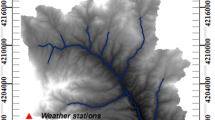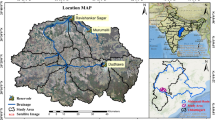Abstract
Uncertainty analysis prior to the model calibration is key to the effective implementation of the hydrologic models. The major application of sensitivity analysis is to indicate the uncertainties in the input parameters of the model, which affects the model performance. There are different optimization algorithms developed and applied in the hydrologic model, which can be performed with different objective functions to calibrate and quantify the uncertainties in the system. The purpose of this study was to evaluate the model calibration performance and sensitivity of parameters using three optimization algorithms and five objective functions for predicting monthly streamflow. Sequential Uncertainty Fitting (SUFI-2), Generalized Likelihood Uncertainty Estimation (GLUE), and Parameter Solution (ParaSol) were used to calibrate the monthly streamflow for the semi-arid San Joaquin Watershed in California by using Soil and Water Assessment Tool (SWAT) model. The best performance metrics (R2, NSE, PBIAS, P-factor, and R-factor) were obtained by SUFI-2 while using NSE as the objective function. The coefficient of determination (R2), Nash–Sutcliffe Efficiency (NSE), the percentage of bias (PBIAS), Kling-Gupta efficiency (KGE) and Ratio of the standard deviation of observations to root mean square error (RSR) were used as an objective function to assess the monthly calibration performance. KGE was found to be a suitable objective function to calibrate this complex and snowmelt-dominated watershed. The findings from this study will serve as a guideline for hydro-ecological researchers to achieve further watershed management goals.







Similar content being viewed by others
References
Abbaspour KC, Yang J, Reichert P, Vejdani M, Haghighat S, Srinivasan R (2008) SWAT calibrating and uncertainty programs–A User Manual. Swiss Federal Institute of Aquatic Science and Technology (EAWAG), Zurich, Switzerland
Abbaspour KC (2013) SWAT-CUP 2012. SWAT Calibration and Uncertainty Program—A User Manual
Abbaspour KC, Johnson C, Van Genuchten MT (2004) Estimating uncertain flow and transport parameters using a sequential uncertainty fitting procedure. Vadose Zone J 3:1340–1352
Abbaspour K, Rouholahnejad E, Vaghefi S, Srinivasan R, Yang H, Kløve B (2015a) A continental-scale hydrology and water quality model for Europe: Calibration and uncertainty of a high-resolution large-scale SWAT model. J Hydrol 524:733–752
Abbaspour KC, Rouholahnejad E, Vaghefi S, Srinivasan R, Yang H, Kløve B (2015b) A continental-scale hydrology and water quality model for Europe: Calibration and uncertainty of a high-resolution large-scale SWAT model. J Hydrol 524:733–752. https://doi.org/10.1016/j.jhydrol.2015.03.027
Arnold JG, Srinivasan R, Muttiah RS, Williams JR (1998) Large area hydrologic modeling and assessment part I: model development. JAWRA 34:73–89
Arnold JG, Moriasi DN, Gassman PW, Abbaspour KC, White MJ, Srinivasan R, Santhi C, Harmel R, Van Griensven A, Van Liew MW (2012) SWAT: model use, calibration, and validation. Trans ASABE 55:1491–1508
Beven K, Binley A (1992) The future of distributed models: model calibration and uncertainty prediction. Hydrol Process 6:279–298
Beven K, Freer J (2001) Equifinality, data assimilation, and uncertainty estimation in mechanistic modelling of complex environmental systems using the GLUE methodology. J Hydrol 249:11–29
Blasone R-S, Vrugt JA, Madsen H, Rosbjerg D, Robinson BA, Zyvoloski GA (2008) Generalized likelihood uncertainty estimation (GLUE) using adaptive Markov Chain Monte Carlo sampling. Adv Water Resour 31:630–648
Box GE, Tiao GC (2011) Bayesian inference in statistical analysis. Wiley, Hoboken
Burke WD, Ficklin DL (2017) Future projections of streamflow magnitude and timing differ across coastal watersheds of the western United States. Int J Climatol 37:4493–4508
Chen H, Luo Y, Potter C, Moran PJ, Grieneisen ML, Zhang M (2017) Modeling pesticide diuron loading from the San Joaquin watershed into the Sacramento-San Joaquin Delta using SWAT. Water Res 121:374–385
Duan Q, Sorooshian S, Gupta V (1992) Effective and efficient global optimization for conceptual rainfall-runoff models. Water Resour Res 28:1015–1031
Eberhart R, Kennedy J (1995) A new optimizer using particle swarm theory. Micro Machine and Human Science, 1995 MHS’95. In: Proceedings of the Sixth International Symposium on. IEEE. pp 39–43
Garcia F, Folton N, Oudin L (2017) Which objective function to calibrate rainfall–runoff models for low-flow index simulations? Hydrol Sci J 62:1149–1166
Gupta HV, Kling H, Yilmaz KK, Martinez GF (2009) Decomposition of the mean squared error and NSE performance criteria: Implications for improving hydrological modelling. J Hydrol 377:80–91
Kennedy J, Eberhart R (1995) Proceedings of IEEE international conference on neural networks. Perth, Australia
Khoi DN, Thom VT (2015) Parameter uncertainty analysis for simulating streamflow in a river catchment of Vietnam. Global Ecol Conserv 4:538–548
Kouchi DH, Esmaili K, Faridhosseini A, Sanaeinejad SH, Khalili D, Abbaspour KC (2017) Sensitivity of calibrated parameters and water resource estimates on different objective functions and optimization algorithms. Water 9:384
Krause P, Boyle D, Bäse F (2005) Comparison of different efficiency criteria for hydrological model assessment. Adv Geosci 5:89–97
Kumar N, Singh SK, Srivastava PK, Narsimlu B (2017) SWAT Model calibration and uncertainty analysis for streamflow prediction of the Tons River Basin, India, using Sequential Uncertainty Fitting (SUFI-2) algorithm. Model Earth Syst Environ 3:30
Lettenmaier DP, Gan TY (1990) Hydrologic sensitivities of the Sacramento-San Joaquin River Basin, California, to global warming. Water Resour Res 26:69–86
Luo Y, Zhang X, Liu X, Ficklin D, Zhang M (2008) Dynamic modeling of organophosphate pesticide load in surface water in the northern San Joaquin Valley watershed of California. Environ Pollut 156:1171–1181
Madsen H (2003) Parameter estimation in distributed hydrological catchment modelling using automatic calibration with multiple objectives. Adv Water Resour 26:205–216
Molina-Navarro E, Hallack-Alegria M, Martinez-Perez S, Ramirez-Hernandez J, Mungaray-Moctezuma A, Sastre-Merlin A (2016) Hydrological modeling and climate change impacts in an agricultural semiarid region. Case study: Guadalupe River basin, Mexico. Agric Water Manag 175:29–42. https://doi.org/10.1016/j.agwat.2015.10.029
Molina-Navarro E, Andersen HE, Nielsen A, Thodsen H, Trolle D (2017) The impact of the objective function in multi-site and multi-variable calibration of the SWAT model. Environ Model Softw 93:255–267
Monteith J (1965) Evaporation and environment. Symp Soc Exp Biol 19:4
Moriasi DN, Arnold JG, Van Liew MW, Bingner RL, Harmel RD, Veith TL (2007) Model evaluation guidelines for systematic quantification of accuracy in watershed simulations. Transa ASABE 50:885–900
Moriasi DN, Gitau MW, Pai N, Daggupati P (2015) Hydrologic and water quality models: performance measures and evaluation criteria. Trans ASABE 58:1763–1785
Morton LW, Olson KR (2014) Addressing soil degradation and flood risk decision making in levee protected agricultural lands under increasingly variable climate conditions. J Environ Protect 5:1220
Muleta MK (2011) Model performance sensitivity to objective function during automated calibrations. J Hydrol Eng 17:756–767
Nash JE, Sutcliffe JV (1970) River flow forecasting through conceptual models part I—A discussion of principles. J Hydrol 10:282–290
Neitsch SL, Arnold JG, Kiniry JR, Williams JR (2011) Soil and water assessment tool theoretical documentation version 2009. Texas Water Resources Institute, Technical Report No. 406. Texas A&M University System. College Station, TX
Paul M (2016) Impacts of land use and climate changes on hydrological processes in South Dakota Watersheds
Paul M, Rajib MA, Ahiablame L (2017) Spatial and temporal evaluation of hydrological response to climate and land use change in three South Dakota watersheds. JAWRA 53:69–88
Rajib MA, Ahiablame L, Paul M (2016) Modeling the effects of future land use change on water quality under multiple scenarios: a case study of low-input agriculture with hay/pasture production. Sustain Water Qual Ecol 8:50–66. https://doi.org/10.1016/j.swaqe.2016.09.001
Rostamian R, Jaleh A, Afyuni M, Mousavi SF, Heidarpour M, Jalalian A, Abbaspour KC (2008) Application of a SWAT model for estimating runoff and sediment in two mountainous basins in central Iran. Hydrol Sci J 53:977–988
Schilling KE, Gassman PW, Kling CL, Campbell T, Jha MK, Wolter CF, Arnold JG (2014) The potential for agricultural land use change to reduce flood risk in a large watershed. Hydrol Process 28:3314–3325
Service USC (1972) Sect. 4: hydrology. In: National Engineering Handbook. SCS, USDA, USA.
Service YW (2017) U.S. Climate Data
Shao W, Cai J, Liu J, Luan Q, Mao X, Yang G, Wang J, Zhang H, Zhang J (2017) Impact of water scarcity on the Fenhe River Basin and Mitigation Strategies. Water 9:30
Singh J, Knapp HV, Arnold J, Demissie M (2005) Hydrological modeling of the Iroquois River watershed using HSPF and SWAT. JAWRA 41:343–360
Singh V, Bankar N, Salunkhe SS, Bera AK, Sharma J (2013) Hydrological stream flow modelling on Tungabhadra catchment: parameterization and uncertainty analysis using SWAT CUP. Curr Sci:1187–1199
Talib A, Randhir TO (2017) Climate change and land use impacts on hydrologic processes of watershed systems. J Water Clim Change 8:jwc2017064
Thiemig V, Rojas R, Zambrano-Bigiarini M, De Roo A (2013) Hydrological evaluation of satellite-based rainfall estimates over the Volta and Baro-Akobo Basin. J Hydrol 499:324–338. https://doi.org/10.1016/j.jhydrol.2013.07.012
Uniyal B, Jha MK, Verma AK (2015) Parameter identification and uncertainty analysis for simulating streamflow in a river basin of Eastern India. Hydrol Process 29:3744–3766
USGS-NED (2013) National Elevation Dataset: United States Geological Survey National Map Viewer.. Available at: http://viewer.nationalmap.gov/viewer/ Accessed 10 March, 2013
van Griensven A, Meixner T (2006) Methods to quantify and identify the sources of uncertainty for river basin water quality models. Water Sci Technol 53:51–59
Wang R, Bowling LC, Cherkauer KA (2016) Estimation of the effects of climate variability on crop yield in the Midwest USA. Agric For Meteorol 216:141–156
Wu H, Chen B (2015a) Evaluating uncertainty estimates in distributed hydrological modeling for the Wenjing River watershed in China by GLUE, SUFI-2, and ParaSol methods. Ecol Eng 76:110–121
Wu H, Chen B (2015b) Evaluating uncertainty estimates in distributed hydrological modeling for the Wenjing River watershed in China by GLUE, SUFI-2, and ParaSol methods. Ecol Eng 76:110–121. https://doi.org/10.1016/j.ecoleng.2014.05.014
Wu Y, Liu S, Li Z (2012) Identifying potential areas for biofuel production and evaluating the environmental effects: a case study of the James River Basin in the Midwestern United States. GCB Bioenergy 4:875–888
Xue C, Chen B, Wu H (2013) Parameter uncertainty analysis of surface flow and sediment yield in the Huolin Basin, China. J Hydrol Eng 19:1224–1236
Yang J, Reichert P, Abbaspour K, Xia J, Yang H (2008) Comparing uncertainty analysis techniques for a SWAT application to the Chaohe Basin in China. J Hydrol 358:1–23
Yapo PO, Gupta HV, Sorooshian S (1996) Automatic calibration of conceptual rainfall-runoff models: sensitivity to calibration data. J Hydrol 181:23–48
Yesuf HM, Melesse AM, Zeleke G, Alamirew T (2016) Streamflow prediction uncertainty analysis and verification of SWAT model in a tropical watershed. Environ Earth Sci 75:806
Zhang J, Li Q, Guo B, Gong H (2015) The comparative study of multi-site uncertainty evaluation method based on SWAT model. Hydrol Process 29:2994–3009
Zhang L, Karthikeyan R, Bai Z, Wang J (2017) Spatial and temporal variability of temperature, precipitation, and streamflow in upper Sang-kan basin, China. Hydrol Process 31:279–295
Acknowledgements
This work was supported by the United States Department of Agriculture-National Institute of Food and Agriculture, Grant number 20166800725064, that established CONSERVE: A Center of Excellence at the Nexus of Sustainable Water Reuse, Food, and Health.
Author information
Authors and Affiliations
Corresponding author
Rights and permissions
About this article
Cite this article
Paul, M., Negahban-Azar, M. Sensitivity and uncertainty analysis for streamflow prediction using multiple optimization algorithms and objective functions: San Joaquin Watershed, California. Model. Earth Syst. Environ. 4, 1509–1525 (2018). https://doi.org/10.1007/s40808-018-0483-4
Received:
Accepted:
Published:
Issue Date:
DOI: https://doi.org/10.1007/s40808-018-0483-4




